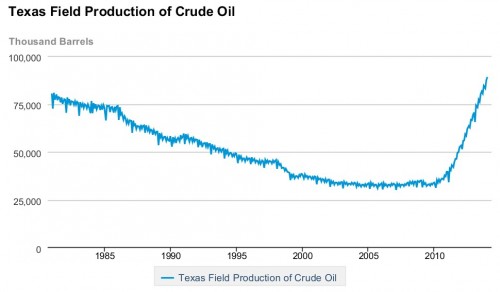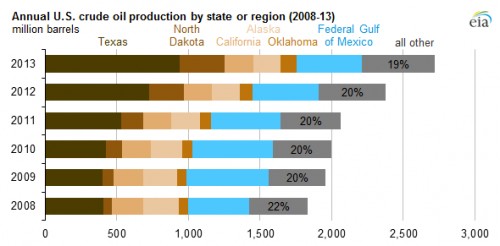The numbers are big enough to take a Texas oilman's breath away, and they're still growing: producers in Texas pumped 2.8 million barrels a day in January, making it the 28th straight month since August 2011 that the state's oil output increased by more than 25% over the year before. According to columnist Mark Perry, this has completely reversed the 28-year decline in the state's oil production from 1981 to 2009, creating a graph more dramatic than a Nike Swoosh.

Three times more production
Just five years ago, before the effects of fracking and horizontal drilling finally kicked in, Texas was producing less than 20% of America's domestic crude oil. That dismal state of affairs had many oilmen storage-lockering their Stetsons and living out of suitcases as they explored overseas for the first time. Now, skyrocketing oil production from the Eagle Ford Shale and the Permian Basin has bumped Texas' share up to 36%. That's three times more than any other state, according to the latest report from the EIA. At that rate, most passports will have expired long before anyone thinks about heading off shore again.
The study also broke production stats down regionally: the Gulf of Mexico produced 17 percent, followed by North Dakota with 12 percent; California and Alaska rounded out the top five crude-producing areas, each adding 7 percent to the total.
Those rankings skewed neatly between conventional and unconventional oil. Heavily fracked North Dakota, recently the seventh largest producer, rose to third, while the Gulf of Mexico, Alaska and California - which pumped half of the US crude in 2008 - have declined to less than a third, giving up ground to the unconventional shale plays.

If Texas were considered a separate country (as some Texans already view themselves), it would be the 10th largest oil-producing nation in the world, slightly behind UAE at 2.82 million bpd and ahead of Kuwait at 2.65 million. But the state should jump in the rankings and become the world's No. 5 oil producer, stampeding over Canada.
With the Eagle Ford and Permian Basin now producing more than 1 million bpd, they've joined an elite group of ten global super-giant oil fields that have produced that much oil at their peak.
50 billion more barrels of oil and gas
And the Texas energy miracle could get much bigger. The Spraberry/Wolfcamp formation along the eastern edge of the Permian Basin has been around for a long time. Although companies have been exploring this tempting, adjacent play since the 1920s, until recently, it was viewed as a non-starter.
But now Pioneer Natural Resources, which claims rights to 900,000 acres, estimates the recoverable oil at 50 billion barrels of oil and gas. That's twice as much as the Eagle Ford and would make the field the largest in the country - the second-largest in the world behind Saudi Arabia's Ghawar.
Like most claims about early shale plays, it's been met with skepticism, but Pioneer CEO Tim Dove told the Dallas News that his company's wells production supported the projection.
Then he explained what makes shale so different: "In shale plays, there are no dry holes by definition. We're more like a manufacturing operation than a traditional oil drilling operation," then he added, "There are thousands of vertical wells out there. We're just starting to drill them horizontally."


